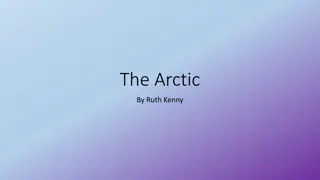Arctic Habitat and Polar Bears: A Conservation Perspective
The Arctic habitat, home to diverse plants and animals like polar bears, faces threats such as climate change, toxic pollution, and oil exploration. Despite past population growth, polar bear numbers are now estimated to be between 22,000 to 31,000. Conservation efforts by Scandinavian countries have shown an increase in Arctic fox numbers. Action is needed to protect these iconic species and their fragile environment.
Download Presentation

Please find below an Image/Link to download the presentation.
The content on the website is provided AS IS for your information and personal use only. It may not be sold, licensed, or shared on other websites without obtaining consent from the author. Download presentation by click this link. If you encounter any issues during the download, it is possible that the publisher has removed the file from their server.
E N D
Presentation Transcript
A Journey to the Arctic Yazan Halaseh Rayan Makhamreh Amir Haddadin Karam Al Saleh
Table of Content Characteristics of the Environment / Animal s habitat. Reasons Behind Extinction. Numbers in the Past and Now. What is Being Done Now to Preserve the Remaining Numbers of that Animal?
Characteristics of the Environment The Arctic habitat is a freezing cold area at the top of the Earth, above the Arctic Circle. It's made up of the Arctic Oceans, as well as areas of the U.S., Canada, Russia, Iceland, Sweden, Finland, Norway and Greenland. It's a diverse habitat, meaning that lots of different plants and animals live there. The Arctic is made up of icy glaciers, sea ice on the Arctic Ocean, and flat plains covered in ice and snow. Animals like polar bears adapt in their environment like having a thick layer of fat under their skin to stay warm and small extremities to prevent heat loss, large webbed feet to prevent sinking in the soft snow and finally the polar bear can close its nose trill to prevent water to get in their while swimming. The Arctic habitat is partly made up of frozen sea-ice, and partly made up of land covered in a layer of permafrost, which is soil that stays frozen throughout the year. On top of that, there's a thin layer of topsoil, which thaws for a short amount of time each year. Arctic plants take root here and grow. There isn't much soil for plants to grow in, however, so they tend to grow low to the ground and together in bunches.
Reasons Behind Extinction Climate change: Climate change, and the loss of sea ice habitat, is the greatest threat to polar bears. Soaring temperatures, rapidly melting ice and snow, rising sea levels and acidifying oceans are threatening all Arctic wildlife, from great whales to tiny plankton not just the iconic polar bear. Toxic pollution: As top predators, such as Polar Bears are exposed to high levels of pollutants through their food. Oil exploration: Expansion of oil and gas drilling in their habitat could be extremely damaging. Direct contact with spilled oil would kill polar bears
Numbers in the Past and Now The polar bear populations had been stable to growing over the past few decades, so the numbers have increased from 23,000 in 1980 to 26,000 in 1995 to increasing by 29,000 in the year 2015, but in the year 2021 there was estimation for the number of polar bears to be around 22,000 to 31,000. Year 2000 2022 Snowy Owl Polar Bear Arctic Hare Seal 100,000 2,659 25,000 21,000 8,000 3,400 1,500 900 Scandinavian countries were able to increase the number of arctic fox from 40 60 adult individuals in year 2000 to an estimated 450 adult Arctic foxes live in Norway, Sweden, and Finland.
What is Being Done Now to Preserve the Remaining Numbers of that Animal? By Living Lifestyle: By walking or driving a bicycle to places as much as possible, so you can limit the amount of use going into the atmosphere because if you don t it will cause Global warming, and it s a huge problem for Arctic animals. By Recycling: it will help because Arctic animals habitat are being destroyed by the lack of recycling, so if we recycling more and care for our environment so the chance of the arctic animals going extinct will reduce.






















